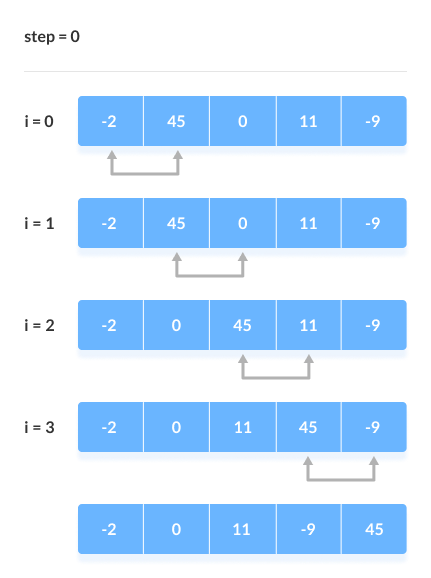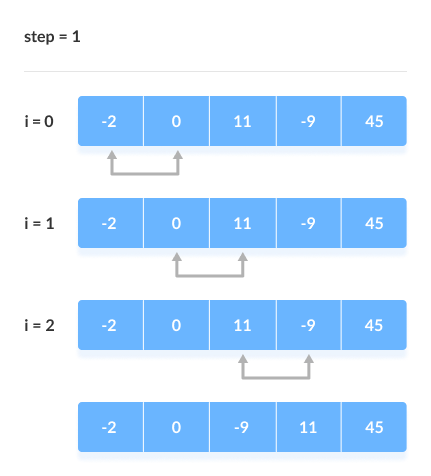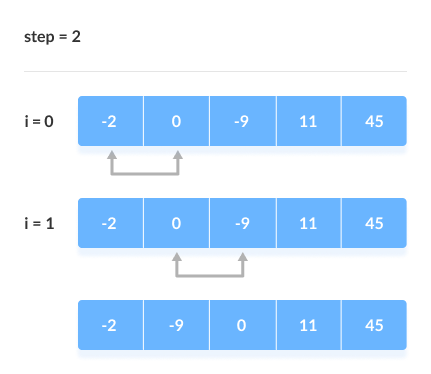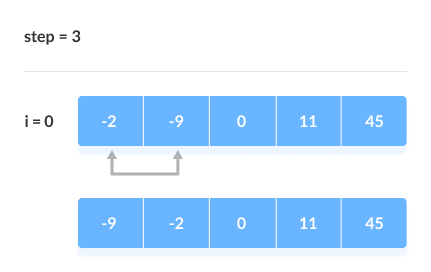冒泡排序是一种排序算法,它比较两个相邻的元素,并在它们不在预期顺序时交换它们。
就像水中的气泡上升到表面一样,数组的每个元素在每次迭代中都会移动到末尾。因此,它被称为冒泡排序。
冒泡排序的工作原理
假设我们正在尝试按升序对元素进行排序。
1. 第一次迭代(比较和交换)
- 从第一个索引开始,比较第一个和第二个元素。
- 如果第一个元素大于第二个元素,则交换它们。
- 现在,比较第二个和第三个元素。如果它们不按顺序排列,则交换它们。
- 上述过程一直持续到最后一个元素。

比较相邻元素
2. 剩余迭代
剩余的迭代过程相同。
每次迭代后,未排序元素中最大的元素将放置在末尾。

每次迭代,比较都会进行到最后一个未排序的元素。

当所有未排序的元素都放置在正确的位置时,数组就排序好了。

冒泡排序算法
bubbleSort(array)
for i <- 1 to sizeOfArray - 1
for j <- 1 to sizeOfArray - 1 - i
if leftElement > rightElement
swap leftElement and rightElement
end bubbleSortPython、Java 和 C/C++ 中的冒泡排序代码
冒泡排序可视化:不要只阅读冒泡排序,观看它的实时演示。通过我们新的 DSA 可视化工具,一步一步地了解算法的每一行是如何工作的。 亲自尝试!
# Bubble sort in Python
def bubbleSort(array):
# loop to access each array element
for i in range(len(array)):
# loop to compare array elements
for j in range(0, len(array) - i - 1):
# compare two adjacent elements
# change > to < to sort in descending order
if array[j] > array[j + 1]:
# swapping elements if elements
# are not in the intended order
temp = array[j]
array[j] = array[j+1]
array[j+1] = temp
data = [-2, 45, 0, 11, -9]
bubbleSort(data)
print('Sorted Array in Ascending Order:')
print(data)// Bubble sort in Java
import java.util.Arrays;
class Main {
// perform the bubble sort
static void bubbleSort(int array[]) {
int size = array.length;
// loop to access each array element
for (int i = 0; i < size - 1; i++)
// loop to compare array elements
for (int j = 0; j < size - i - 1; j++)
// compare two adjacent elements
// change > to < to sort in descending order
if (array[j] > array[j + 1]) {
// swapping occurs if elements
// are not in the intended order
int temp = array[j];
array[j] = array[j + 1];
array[j + 1] = temp;
}
}
public static void main(String args[]) {
int[] data = { -2, 45, 0, 11, -9 };
// call method using class name
Main.bubbleSort(data);
System.out.println("Sorted Array in Ascending Order:");
System.out.println(Arrays.toString(data));
}
}// Bubble sort in C
#include <stdio.h>
// perform the bubble sort
void bubbleSort(int array[], int size) {
// loop to access each array element
for (int step = 0; step < size - 1; ++step) {
// loop to compare array elements
for (int i = 0; i < size - step - 1; ++i) {
// compare two adjacent elements
// change > to < to sort in descending order
if (array[i] > array[i + 1]) {
// swapping occurs if elements
// are not in the intended order
int temp = array[i];
array[i] = array[i + 1];
array[i + 1] = temp;
}
}
}
}
// print array
void printArray(int array[], int size) {
for (int i = 0; i < size; ++i) {
printf("%d ", array[i]);
}
printf("\n");
}
int main() {
int data[] = {-2, 45, 0, 11, -9};
// find the array's length
int size = sizeof(data) / sizeof(data[0]);
bubbleSort(data, size);
printf("Sorted Array in Ascending Order:\n");
printArray(data, size);
}// Bubble sort in C++
#include <iostream>
using namespace std;
// perform bubble sort
void bubbleSort(int array[], int size) {
// loop to access each array element
for (int step = 0; step < size -1; ++step) {
// loop to compare array elements
for (int i = 0; i < size - step - 1; ++i) {
// compare two adjacent elements
// change > to < to sort in descending order
if (array[i] > array[i + 1]) {
// swapping elements if elements
// are not in the intended order
int temp = array[i];
array[i] = array[i + 1];
array[i + 1] = temp;
}
}
}
}
// print array
void printArray(int array[], int size) {
for (int i = 0; i < size; ++i) {
cout << " " << array[i];
}
cout << "\n";
}
int main() {
int data[] = {-2, 45, 0, 11, -9};
// find array's length
int size = sizeof(data) / sizeof(data[0]);
bubbleSort(data, size);
cout << "Sorted Array in Ascending Order:\n";
printArray(data, size);
}优化冒泡排序算法
在上述算法中,即使数组已经排序,也会进行所有比较。
这会增加执行时间。
为了解决这个问题,我们可以引入一个额外的变量 swapped。如果发生元素交换,则将 swapped 的值设置为 true。否则,设置为false。
一次迭代后,如果没有发生交换,则 swapped 的值将为false。这意味着元素已经排序,无需进行进一步的迭代。
这将减少执行时间,并有助于优化冒泡排序。
优化冒泡排序的算法是
bubbleSort(array)
for i <- 1 to sizeOfArray - 1
swapped <- false
for j <- 1 to sizeOfArray - 1 - i
if leftElement > rightElement
swap leftElement and rightElement
swapped <- true
if swapped == false
break
end bubbleSortPython、Java 和 C/C++ 中的优化冒泡排序
优化冒泡排序可视化:不要只阅读优化冒泡排序,观看它的实时演示。通过我们新的 DSA 可视化工具,一步一步地了解算法的每一行是如何工作的。 亲自尝试!
# Optimized Bubble sort in Python
def bubbleSort(array):
# loop through each element of array
for i in range(len(array)):
# keep track of swapping
swapped = False
# loop to compare array elements
for j in range(0, len(array) - i - 1):
# compare two adjacent elements
# change > to < to sort in descending order
if array[j] > array[j + 1]:
# swapping occurs if elements
# are not in the intended order
temp = array[j]
array[j] = array[j+1]
array[j+1] = temp
swapped = True
# no swapping means the array is already sorted
# so no need for further comparison
if not swapped:
break
data = [-2, 45, 0, 11, -9]
bubbleSort(data)
print('Sorted Array in Ascending Order:')
print(data)// Optimized Bubble sort in Java
import java.util.Arrays;
class Main {
// perform the bubble sort
static void bubbleSort(int array[]) {
int size = array.length;
// loop to access each array element
for (int i = 0; i < (size-1); i++) {
// check if swapping occurs
boolean swapped = false;
// loop to compare adjacent elements
for (int j = 0; j < (size-i-1); j++) {
// compare two array elements
// change > to < to sort in descending order
if (array[j] > array[j + 1]) {
// swapping occurs if elements
// are not in the intended order
int temp = array[j];
array[j] = array[j + 1];
array[j + 1] = temp;
swapped = true;
}
}
// no swapping means the array is already sorted
// so no need for further comparison
if (!swapped)
break;
}
}
public static void main(String args[]) {
int[] data = { -2, 45, 0, 11, -9 };
// call method using the class name
Main.bubbleSort(data);
System.out.println("Sorted Array in Ascending Order:");
System.out.println(Arrays.toString(data));
}
}// Optimized Bubble sort in C
#include
// perform the bubble sort
void bubbleSort(int array[], int size) {
// loop to access each array element
for (int step = 0; step < size - 1; ++step) {
// check if swapping occurs
int swapped = 0;
// loop to compare array elements
for (int i = 0; i < size - step - 1; ++i) {
// compare two array elements
// change > to < to sort in descending order
if (array[i] > array[i + 1]) {
// swapping occurs if elements
// are not in the intended order
int temp = array[i];
array[i] = array[i + 1];
array[i + 1] = temp;
swapped = 1;
}
}
// no swapping means the array is already sorted
// so no need for further comparison
if (swapped == 0) {
break;
}
}
}
// print array
void printArray(int array[], int size) {
for (int i = 0; i < size; ++i) {
printf("%d ", array[i]);
}
printf("\n");
}
// main method
int main() {
int data[] = {-2, 45, 0, 11, -9};
// find the array's length
int size = sizeof(data) / sizeof(data[0]);
bubbleSort(data, size);
printf("Sorted Array in Ascending Order:\n");
printArray(data, size);
} // Optimized bubble sort in C++
#include <iostream>
using namespace std;
// perform bubble sort
void bubbleSort(int array[], int size) {
// loop to access each array element
for (int step = 0; step < (size-1); ++step) {
// check if swapping occurs
int swapped = 0;
// loop to compare two elements
for (int i = 0; i < (size-step-1); ++i) {
// compare two array elements
// change > to < to sort in descending order
if (array[i] > array[i + 1]) {
// swapping occurs if elements
// are not in intended order
int temp = array[i];
array[i] = array[i + 1];
array[i + 1] = temp;
swapped = 1;
}
}
// no swapping means the array is already sorted
// so no need of further comparison
if (swapped == 0)
break;
}
}
// print an array
void printArray(int array[], int size) {
for (int i = 0; i < size; ++i) {
cout << " " << array[i];
}
cout << "\n";
}
int main() {
int data[] = {-2, 45, 0, 11, -9};
// find the array's length
int size = sizeof(data) / sizeof(data[0]);
bubbleSort(data, size);
cout << "Sorted Array in Ascending Order:\n";
printArray(data, size);
} 冒泡排序复杂度
| 时间复杂度 | |
|---|---|
| 最佳 | O(n) |
| 最坏 | O(n2) |
| 平均 | O(n2) |
| 空间复杂度 | O(1) |
| 稳定性 | 是 |
复杂度详解
冒泡排序会比较相邻的元素。
| 循环 | 比较次数 |
|---|---|
| 第 1 次 | (n-1) |
| 第 2 次 | (n-2) |
| 第 3 次 | (n-3) |
| ....... | ...... |
| 最后 | 1 |
因此,比较次数为
(n-1) + (n-2) + (n-3) +.....+ 1 = n(n-1)/2约等于 n2
因此,复杂度:O(n2)
另外,如果我们观察代码,冒泡排序需要两个循环。因此,复杂度为 n*n = n2
1. 时间复杂度
-
最坏情况复杂度:
O(n2)
如果要按升序排序,而数组按降序排列,则会发生最坏情况。 -
最佳情况复杂度:
O(n)
如果数组已经排序,则无需排序。 -
平均情况复杂度:
O(n2)
当数组的元素混乱(既非升序也非降序)时,就会发生这种情况。
2. 空间复杂度
- 空间复杂度为
O(1),因为使用了额外的变量进行交换。 - 在优化冒泡排序算法中,使用了两个额外的变量。因此,空间复杂度为
O(2)。
冒泡排序的应用
如果需要,则使用冒泡排序
- 复杂度不重要
- 倾向于简洁明了的代码
